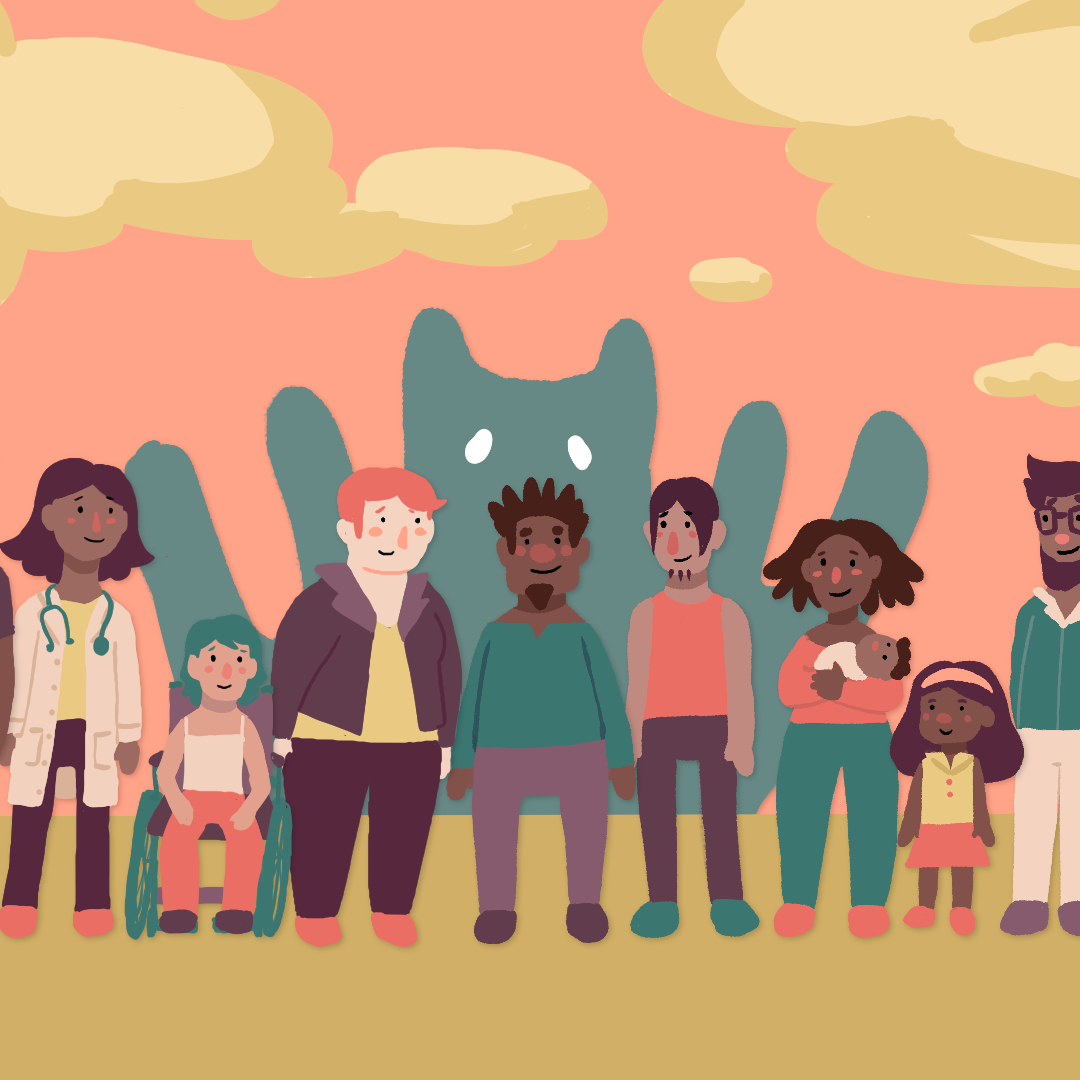Humanizing the experience of HIV-stigma through animation
Published July 18, 2022 in BMC News
A still from biomedical visualization specialist Jenn Lee’s 2D-animation End HIV-stigma. (Used with permission.)
In her second year of the Master of Science in Biomedical Communications program, Jenn Lee sat in a coffee shop where she sketched ideas for her master's research project. She needed to create a visual representation for stigma.
Stigma occurs when people simultaneously experience some or all of discrimination, loss of status, being labelled, stereotyped, and separated. Stigma does not have a physical shape or form.
"I thought of it as something that always follows you around but also changes. I thought, stigma is kind of like a beast, like the monster hiding in your closet." That's when the blob monsters, as she calls them, materialized. "And it just felt right."
Lee, who graduated from the University of Toronto with her MScBMC in 2021, created a 2D-animation for her capstone project.
End HIV Stigma is an emotionally affecting video designed to help the public understand what HIV stigma is, and its debilitating effects. Using monsters endowed with human characteristics, she makes stigma real and visible for audiences.
The Positive Effect
In 2019, REACH Nexus, a national centre working to address HIV, Hepatitis C and other sexually transmitted and blood-borne infections in Canada, launched PostiveEffect.org, as a place to engage people through stories.
"The Positive Effect is really a movement. It's emotive. It's resilience based. It's about how you can think about stigma, learn how other people have navigated through the challenges, and about helping people to get on the right path," says Sean Rourke, director of REACH Nexus.
Continually on the search for novel and innovative ways to educate the public about HIV Stigma, he settled on animation and posted a master’s research project with the Biomedical Communications program.
Lee, who had earned a master's degree in public health before joining the Biomedical Communications program, and who had some experience in HIV research, knew right away that she wanted to work on this project.
"HIV stigma is alive and well in Canada, and we really need to correct all the misinformation and the myths that people have about HIV, and help people get access to care," says Rourke, also a scientist with MAP Centre for Urban Health Solutions at St. Michael's Hospital. "HIV stigma is a barrier to testing, treatment and support, which increases the potential for HIV transmission."
Community-informed ideation and creation
Casting call. Jenn Lee created a broad cast of characters so that most people could find at least one character they could relate to. (Image credit: Jenn Lee. Used with permission.)
"Initially, we thought that the project would be more about data visualization and showing findings from the HIV Stigma Index. But after speaking with people who live with HIV, we found that there were things that the public didn't understand and that it would be more important to take a story-based approach and evoke a more emotional response," says Lee.
Rourke connected Lee with one of the investigators on the HIV Stigma Index. The investigator helped Lee to create a community advisory committee of seven people, six of whom disclosed that they lived with HIV. Lee consulted with them on the animation's content, message, and script.
Representation was also important to Lee. "HIV affects such a wide range of populations, and many of them are marginalized. I thought it was really important to have a broad cast of characters so that most people could find at least one character they could relate to."
Lee says that diverse representation of people in all media, and especially in medical illustration, is vital. "From the healthcare providers depicted, to the friends and family–I thought it was really important to make sure people felt represented."
To focus on movement and making emotions natural, Lee chose 2D-animation for the story’s medium. "Because I could hand-draw some of it, it really helped to make it feel more organic,” she says.
The blob monsters made stigma more tangible. "Having them visible was important to show how different stigma is for everyone."
Lee used size to convey how stigma can, at times, be overwhelming or more manageable but never completely go away. She used colour to convey shifts in mood.
Rourke says Lee creatively communicated “those things which are internal, and which everyone has their own way of describing, into something that transcends the individual experience. I think the animation is very effective in humanizing the experience of stigma and letting people know that there are things you can do about it. Small steps can be huge advances."
Lee attributes the success of her End HIV Stigma animation to the support she received from the community advisory committee, her Biomedical Communications research supervisors Shelley Wall and Derek Ng, and to Rourke. "I was really lucky to have a clinical advisor who was so engaged and committed."
Now a biomedical communications designer at Bridgeable, Lee translates complex pharma-related medical information to make it more accessible for patients. "I look forward every day to being able to continue to apply the skills I learned at BMC to everything that comes next."
~
Web sites referenced in story
Jenn Lee Visuals https://jennleevisuals.ca/
End HIV Stigma https://vimeo.com/623855123
The Positive Effect https://www.positiveeffect.org/



